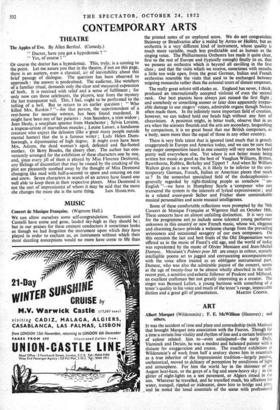ART
IT was the accident of time and place and comradeship (with Matisse) that brought Marquet into association with the Fauves. Though for a time a certain free vitality and rhythm of line and a certain brilliance of colour related, him to—even anticipated—the early Dufy, Vlaminck and Derain, he was a modest and balanced painter with a distaste' for exaggeration and excess. The excellent exhibition at Wildenstein's of work from half a century shows him in essentials as a true inheritor of the Impressionist tradition—largely passive, unrhetorical, moved to ,delicacy of perception by conditions of light and atmosphere. For him the world lay in the shimmer of an August heat-haze, or the greys of a fog and snow-heavy sky ; in the glitter of night-lights on a wet pavement, or Algiers rinsed in the sfin. Wherever he travelled, and he travelled much, his affection for water, tranquil, rippled or iridescent, drew him to bridge and jetty, and he noted the tonal essentials of the scene with professional
simplicity and restraint. He was a slighter painter than, say, Bon- nard or Sicken, but his single-mindedness carved him a little niche that seems likely to remain.
F. E. McWilliam's post-war sculpture, with its decorative assembly of classical limbs and fragments (of which someone said unkindly that " the holes are greater than the parts "), has owed a little to Moore, more to Surrealism. The Matriarch at the Hanover Gallery, who balances her progeny within her own spindly framework, continues the theme, but this new exhibition also shows McWilliam essaying a new manner. His series of Cain struggling with Abel, ingeniously compounded of wire and metal, are in the fashionably elongated forms that have sprung, in the first place, from Giacometti. (There is a hint too of drawings by Reg Butler.) It will be interesting to see the artist working out this new seam. Robin Campbell, upstairs, explores the methods of the early Cubists with vigour and transparent integrity. His paintings have a strength and rough- hewn freshness as- though these discoveries were being made for the first time.
Among other little-known names to be noted among the current shows are those of Terry Frost, whose abstract recollections of Cornwall share the Leicester Galleries with a selection from W. A. Evill's collection ; Benjamin Creme, a young Scot who studied with Jankel Adler, at the Galerie Apollinaire ; Peter Startup, whose variations upon a bicycle theme are about to disappear from Messrs. Roland, Browse and Delbanco. At Charing Cross Underground Station the Observer's very lively exhibition of ceramics (with daily demonstrations by potters) continues to the end of the month.
M. H. MIDDLETON.



































 Previous page
Previous page